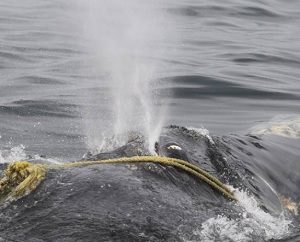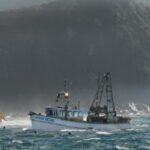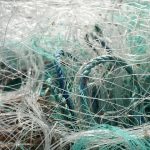Tag Archives: Gulf of St. Lawrence

The Risk of Ship Strikes: Maine Congressional Delegation Ask Feds To Shift Focus Of Right Whale Protections
In a letter to top officials at the National Oceanic and Atmospheric Administration (NOAA) this week, the delegation calls on the agency to provide more information about reducing the risk of ship strikes off the United States and Canada – strikes that they say are as much a threat to the whales’ survival as entanglement with lobster fishing gear. >click to read< 10:13
 Most likely Carnival Cruise Lines is responsible for 18+ Right Whale deaths in the past 3 year, at which rate they would soon be extinct – >click to read<
Most likely Carnival Cruise Lines is responsible for 18+ Right Whale deaths in the past 3 year, at which rate they would soon be extinct – >click to read<

US elected officials discuss Canadian crab embargo
In a letter to Commerce Secretary Wilbur Ross, a member of President Donald Trump’s Cabinet, four elected officials from Maine stand up for their state’s lobster fishing industry. They argue that measures to protect the North Atlantic right whale imposed on American fishermen for several years have saved the species from extinction, but also increased its population. However, they add, the mortality of right whales “directly related” to commercial shipping and fishing activities in Canadian waters “continues to increase”. A total of 12 right whales died in the Gulf of St. Lawrence in 2017 and at least 9 in 2019, out of a population of around 400 individuals. >click to read<14:13
Des élus américains évoquent un embargo sur le crabe canadien – >click to read<
Most likely Carnival Cruise Lines is responsible for 18+ Right Whale deaths in the past 3 year, at which rate they would soon be extinct. – >click to read<

Energy conglomerate spent $14.5M to bury subsea cables as result of unexpected redfish population boom!
It’s a fish story no one saw coming, at least not Halifax-based energy conglomerate Emera. The parent company of Nova Scotia Power disclosed this week to the Utility and Review Board that it spent almost $14,492,000 this summer to bury its Maritime Link cables lying on the floor of the Cabot Strait between Newfoundland and Cape Breton. The cables were protected because an unprecedented explosion in the redfish population in the Gulf of St Lawrence is about to trigger a corresponding boom in bottom trawling in the area. >click to read< 10:09

Most likely Carnival Cruise Lines is responsible for 18+ Right Whale deaths in the past 3 year, at which rate they would soon be extinct.
Human caused Right whale deaths have suddenly, in sync with a plummeting whale birthrate, put the right whale on the path to extinction.,,, There is the simple answer, to halt the march towards extinction. There is an easy way to prevent those 18 deaths and at least bring that -18 up to 0. We can stop the majority of the anthropogenic Whale deaths with a simple Cruise Ship lane modification between PEI and the tip of the Gaspe Peninsula. Prior to 2007 ships were almost solely responsible for Right whale deaths, but since 2008 fishing line entanglement deaths have increased and fishermen have become the main target. However data from the past 3 years indicate many more ship strike deaths than entanglement deaths. >click to read< 12:41

Science Advances report says marine protected areas may not be enough to preserve biodiversity
The paper published Wednesday in the journal Science Advances said climate change will erode the effectiveness of “static” marine protected areas across the globe, and “dynamic ocean management” is needed to preserve biodiversity when species or ecosystems move because of a changing ocean. When the critically endangered whales appeared unexpectedly in the Gulf of St. Lawrence in 2017, the results were disastrous. Twelve right whales whales died and Canada implemented speed limits in shipping lanes and temporary fishing-zone closures. Nine more died this year. >click to read< 09:05

‘Find some good solutions’: governments, experts, fishermen prepare for 2020 right whale regulations
An annual roundtable meeting held by officials with the Department of Fisheries and Oceans has wrapped up after discussing how to deal with the declining North Atlantic right whale population. The subject has become controversial after at least nine confirmed deaths in 2019, with several preliminary findings indicating vessel strikes were the cause. Some of the deaths came despite the Canadian government cracking down tighter on fisheries closures and speed restrictions, but the impact on the fishing industry is part of what makes regulations such a controversial topic. >click to read< 08:43
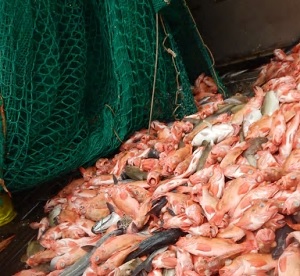
Fishing industry welcomes move, Emera forced to bury a third of Maritime Link’s submarine cable
Halifax-based energy conglomerate Emera buried 59 kilometres of electrical cables beneath the ocean floor between Nova Scotia and Newfoundland this past summer to protect the Maritime Link from “substantially increased” bottom fishing the company did not see coming. Completed in 2017, the $1.5-billion Maritime Link was built to carry electricity generated from the Muskrat Falls hydro project in Labrador into Nova Scotia and on to New England. The company is responding to an unforeseen explosion in the population of redfish in the Gulf of St. Lawrence,,, >click to read< 10:48

Seals are overfishing at unsustainable rates! Gulf of St. Lawrence cod extinction ‘highly probable,’
“At the current abundance of grey seals in this ecosystem, recovery of this cod population does not appear to be possible, and its extinction is highly probable,” the report says. DFO fish biologist Doug Swain said the cod population is now about five per cent of levels in the 1980s, and the downward spiral is accelerating despite a moratorium on a directed cod fishery in the Gulf since 2009. The problem is an “extremely high” and “unsustainable” death rate for cod five years or older. >click to read< 11:29

2 Canadian Coast Guard ships fined for speeding in right whale slowdown zone
Two Canadian Coast Guard vessels were among the six ships fined Monday after being caught violating speed restrictions aimed at protecting North Atlantic right whales. Transport Canada fined the coast guard ships Cape Edensaw and Cap d’Espoir $6,000 and $12,000 respectively for violating the temporary mandatory slowdown in the shipping lanes north and south of Anticosti Island in the Gulf of St. Lawrence. >click to read< 09:10

How Ship Strikes Have Become The Greatest Threat To Right Whales
This is the first of a two-part report explaining how vessel strikes happen, why they’re increasing and what’s being done to stop them. In the last month, eight North Atlantic right whales have been found dead in Canada’s Gulf of St. Lawrence, including two members of the critically endangered species this past week. Canadian authorities say work to determine these new whales’ cause of death is ongoing. Whatever the cause of these latest deaths, researchers worry collisions with ships are increasingly to blame. >click to read< 20:24

International shipping industry under increased scrutiny as whale death toll grows
The shipping industry is under increased scrutiny after two cargo ships were fined for sailing too fast through the Gulf of St. Lawrence, where the rising death toll among endangered North Atlantic right whales has been partly blamed on collisions with vessels. There have been eight deaths reported since early June, and examinations of five of the carcasses showed three of them had injuries consistent with ship strikes, a leading cause of death for these rare mammals. 227 vessels exceeded speed limit in 3 months >click to read< 11:23

Experts track right whale behavior in new trouble spot
Scientists from the U.S. and Canada have returned from a North Atlantic right whale survey trip in the southern Gulf of St. Lawrence where they found dense reserves of zooplankton that have drawn 70 or more of the critically endangered marine mammals to the region this summer. They now expect the right whales to move farther north in the coming summers to follow the movement of the food they consume,,, Many of the right whales that visit Cape Cod Bay and south of the islands in the late winter and early spring migrate northward as they follow the movement of zooplankton, especially a rice-sized copepod called calanus. >click to read< 09:58

Mills’ stand on fishing rules praised by lobster industry
As Executive Director of the Maine Lobstermen’s Association (MLA), I applaud Gov. Mills’ July 11 Message to Maine’s Lobster Industry acknowledging the federal government’s “disturbing lack of evidence connecting the Maine lobster industry to recent right whale deaths.”,,, What is often lost in this debate is that the population of North Atlantic right whales was only 295 in 1997 when federal regulators first required U.S. fishermen to implement conservation measures. In the ensuing years, the right whale population increased to more than 450 whales. >click to read< 11:17

Fishermen volunteer to become 2nd right whale rescue team
Ferron is one of three crab fishermen who volunteered to form a new rescue team based in Shippagan. He, Martin Noël and Rémi Guignard have been training since last winter. The objective is to eventually have a boat to respond quickly to disentanglement calls in the Gulf of St. Lawrence.,,, Jean Lanteigne, director of the Regional Acadian Federation of Professional Fishermen, said the Campobello Whale Rescue team first approached the fishermen to see if anyone was interested in volunteering. Fifteen fishermen showed up for the information session, but three had the time to commit to the training schedule. >click to read< 17:18

More needs to be done to identify travel paths of North Atlantic right whales, scientist says
The Canadian and U.S. governments need to know exactly where North Atlantic right whales are travelling to better protect them, a whale researcher says. “There have been whales in locations that the Canadian government may not have known about, at least early enough, ” said Charles (Stormy) Mayo, director of the North Atlantic Right Whale Ecology program at the Center for Coastal Studies in Provincetown, Mass. “It’s a very thorny problem and the more that Canada can do, the better off we are.” >click to read< 20:29

Canada: Two more right whales found dead off east coast, bringing total to eight this year
One of the dead whales was first observed Thursday by an aerial surveillance flight drifting west of the Magdalen Islands in the Gulf of St. Lawrence, the Department of Fisheries and Oceans said in a news release. It was located Friday by a vessel in the area, and a necropsy is scheduled to take place Sunday. Also Friday, the body of a second dead right whale was sighted off Glace Bay, N.S., according to the fisheries department. “Neither of these whales have yet been individually identified,” the department said in a news release, adding that the government “takes this issue very seriously.”,,, No right whales died in Canadian waters last year, but 12 were found dead in the Gulf of St. Lawrence in 2017>click to read< 20:18

Transport Canada – New protective measures announced for North Atlantic right whales
Transport Canada has announced further protective measures in the Gulf of St. Lawrence for the North Atlantic right whale. The measures, announced Monday evening, include further reducing ship speeds in the area, increasing zones in which the speed restrictions will apply, increasing aerial surveillance and funding for initiatives to enhance marine mammal response. In 2019, there have been six whale deaths reported and on July 8, there were three North Atlantic right whales entangled in the southern waters of the Gulf of St. Lawrence,,, >click to read<21:03

Right whale protections may not be enough, federal review shows
Measures taken to protect North Atlantic right whales in the Gulf of St. Lawrence from being struck by ships and getting caught in fishing gear may not be enough, a scientific review by Ottawa shows.,, The review was done late last year by scientists who work in federal departments and universities across Canada, looking at data compiled by marine-mammal experts over the last three years.,, Aerial surveys estimate there were at least 190 right whales in the Gulf last year, half the total known population everywhere. (and none died) >click to read< 12:57
Immediate Action Needed to Save North Atlantic Right Whales – Chris Oliver, Assistant Administrator for NOAA Fisheries >click to read<
Kennebunk Town Column: Invisible lines threaten lobster fishery – Lobstermen are facing the real threat of being forced out of business and a livelihood that they have relied on for many generations. >click to read<

Transport Canada implements speed limits following death of another right whale
Transport Canada has implemented a speed restriction for vessels in the western part of the Gulf of St. Lawrence following yet another death of the endangered North Atlantic right whale on Wednesday. Fisheries and Oceans Canada confirmed a right whale was found dead on the shores of Anticosti Island near the Gulf of St. Lawrence, bringing the number of recent deaths up to five. Scientists are on scene collecting samples for analysis, and working with various partners to assess necropsy options, said a news release from the fisheries department. >click to read<18:07

Researchers regroup in wake of 4 right whale deaths
It’s been a deadly month for the endangered mammals, with the carcasses of two other whales — an adult female and a 9-year-old male — reported June 4 and June 20, also in the Gulf of St. Lawrence. Photo analysis of the carcasses found Tuesday identified one as a 33-year-old male named Comet and the other as an unnamed 11-year-old female who had no documented calf, according to New England Aquarium’s Anderson Cabot Center for Ocean Life. The two carcasses were seen near the Acadian Peninsula in New Brunswick and west of the Magdalen Islands in Quebec, according to Canadian officials.,,, The National Oceanic and Atmospheric Administration is taking part in preplanned talks with the Canadian government on North Atlantic right whale protections this week in Halifax, Nova Scotia, NOAA spokeswoman Jennifer Goebel said. >click to read<20:56

2 more dead right whales discovered in Gulf of St. Lawrence
Two more dead North Atlantic right whales have been found in the Gulf of St. Lawrence, says Fisheries and Oceans Canada. The whales were located near the Acadian Peninsula of New Brunswick and west of the Magdalen Islands, a department news release said Tuesday. They are the third and fourth confirmed deaths of North Atlantic right whales to be reported in Canadian waters this year. >click to read<07:47

Winter skate are dying in huge numbers, a new scientific paper points the finger at a big herd of seals
A “striking conservation success” in Atlantic Canada has turned into a “serious conservation problem” as rebounding grey seal herds threaten depleted bottom-feeding fish in the southern Gulf of St. Lawrence, according to a new research paper from Canadian and U.S. scientists. The focus is on the winter skate, a little-known shark relative with a flat body and a long tail. “It’s quite dire. The skate have declined by 98 per cent since the mid-80s,” said Doug Swain, a federal fisheries scientist based in Moncton, N.B. The paper concludes grey seals are the likely cause of an “unprecedented” winter skate annual adult mortality rate of between 65 and 70 per cent. >click to read<09:20

Maine lobster fishery agrees to deep cuts to protect whales
After a long and difficult week in late April in which the National Oceanographic and Atmospheric Administration’s Marine Mammal Take Reduction Team met to address protections for the endangered right whale, the Maine lobster fishery now has a sense of what the future holds. There were some hard battles along the way, in which we lobster industry advocates fought to ensure a viable Maine fishery, both for today’s lobstermen and for future generations. By Patrice McCarron >click to read<14:39
Competing interests – “The farmer and the cowman should be friends,” according to Richard Rodgers’ lyrics in “Oklahoma!” Can a similar peace pact be visited upon Maine’s lobstermen and the advocates of whale safety? >click to read<

Redfish rebound in Gulf of St. Lawrence show no signs of slowdown
Redfish biomass surged by 20 per cent last year and is now estimated at a staggering three million tonnes, according to Canada’s Department of Fisheries and Oceans. “The biomass that we’re seeing right now is something that we have never seen before,” said DFO biologist Caroline Senay of the redfish, also known as ocean perch. The massive population is primarily made of of fish live born — not hatched from eggs — from 2011, 2012 and 2013. The region’s fishing industry has been licking its chops for several years over the prospect of a redfish bonanza.,,, Eating down northern shrimp. But the sheer size of the population is likely affecting other species. >click to read<12:15
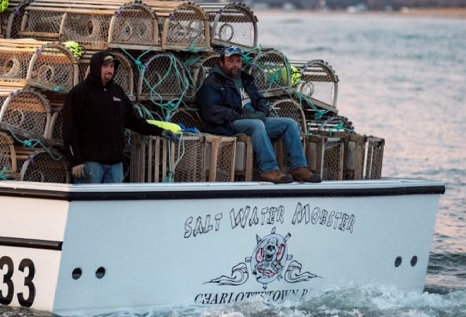
An early start to a late setting day for P.E.I.’s lobster fishermen
The lobster boats are off and heading to a staging area outside the North Rustico harbour on the North Shore of Prince Edward Island Friday morning, waiting for the 6 a.m. start time. According to federal fisheries rules, the boats can’t go until the appointed hour.,,, The wharf and breakwater of North Rustico was crowded with spectators as the boats set out into the Gulf of St. Lawrence. This year was a bit unusual in that setting day was supposed to be April 29, but because of bad weather it was delayed until May 3. Brian McInnis is a Charlottetown-based freelance photographer. >Excellent photo’s, click to read<11:52

‘Neither country can save the species on its own’ – Reduce amount of rope in water to protect right whales, says U.S. advisory group
The National Oceanic and Atmospheric Administration (NOAA) Atlantic Large Whale Take Reduction Team held four days of meetings ending Friday.
The group proposes the number of lines in the water be reduced by up to 50 per cent in some jurisdictions and that the breaking strength of buoy lines be reduced to 1,700 pounds (771 kilograms) or less. Now the onus is on the U.S. National Marine Fisheries Service to consider acting on those recommendations. While researchers from both countries agree that there needs to be less rope in the water, the recommendations are a different approach to that of the Canadian government, which imposed fisheries closures in the Gulf of St. Lawrence last year and again in 2019. >click to read<09:20

Malpeque Harbour channel plugged; fishermen remaining tied up as dredge works at site
When P.E.I.’s lobster fleet heads out for setting day on Monday, their fellow captains in Malpeque Harbour might be left watching from the wharf.
An unprecedented amount of sand has moved in over the winter to choke off the narrow channel that gives the small harbour on P.E.I.’s north shore access to the Gulf of St. Lawrence. A dredger is on site and working to get the passage open but, with setting day tentatively set for April 29, fishermen who use the wharf are worried – and frustrated. >click to read<13:24

FISH-NL calls on Ottawa for ice compensation for west coast harvesters
The Federation of Independent Sea Harvesters of Newfoundland and Labrador (FISH-NL) is calling on Ottawa to extend EI benefits for fish harvesters on Newfoundland’s west coast impacted by severe ice conditions in the Gulf of St. Lawrence. “Some harvesters and their families are having a hard time of it. The heavy ice means they can’t go fishing, and the wolf is beating at the door,” says Ryan Cleary, President of FISH-NL, in calling for ice compensation in the form of an EI extension. >click to read<17:15

‘Huge increase’ in fishing ahead – Could a redfish trawling bonanza zap the Maritime Link?
Owners of the Maritime Link are exploring whether the two subsea electrical cables between Newfoundland and Nova Scotia will need to be better protected from fishing gear when seafood companies begin harvesting an exploding biomass of redfish in the region. Scientists say there are at least 2.5 million tonnes of redfish in the Gulf of St. Lawrence, and that is expected to trigger an Atlantic Canadian fishing bonanza — including more bottom trawling — when the fish reach harvest size in a year or two. >click to read< 08:59






